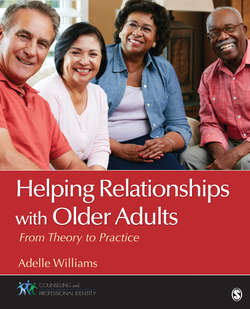Читать книгу Helping Relationships With Older Adults - Adelle M. Williams - Страница 33
На сайте Литреса книга снята с продажи.
Respiratory System
ОглавлениеThe major function of the respiratory system is the delivery of air to sites in the lungs where gas exchange can occur between the air and circulating blood (AAHF, 2015). The lungs have two main functions. One function is to get oxygen from the air into the body, and the other function is to remove carbon dioxide from the body. The body needs oxygen to work properly, and carbon dioxide is a gas the body produces when it uses oxygen (Martin, 2014). During breathing, air enters and exits the lungs. When you breathe in (inhale), air flows through the airways into the lungs. The airways are made of stretchy tissue and bands of muscle, and other support tissue wraps around each airway to help keep it open. Air keeps flowing into the lungs until it fills tiny air sacs, and blood circulates around these sacs through tiny blood vessels. Oxygen crosses into the bloodstream at the place where the vessels and air sacs meet, and this is also where carbon dioxide crosses the bloodstream into the lungs to be breathed out (exhaled) (Martin, 2014).
As a result of aging changes in the body, older people are at increased risk for lung infections (i.e., pneumonia, bronchitis), shortness of breath, low oxygen level, and abnormal breathing patterns resulting in problems such as sleep apnea (episodes of stopped breathing during sleep) (Martin, 2014). Mental health professionals can create a supportive environment to provide health education to encourage the older client to decrease or eliminate smoking (if appropriate) and to encourage an exercise to improve lung function. Lying around for long periods of time allows mucus to collect in the lungs and places the older adult at risk for lung infections. Mental health practitioners will address concerns, fears, and psychological issues, which may impede the recovery process. Coordination of services and arranging access to obtain needed equipment (if required) will be an essential component of the therapeutic process.
Aging changes in the body that affect the lungs include changes to the bones and muscles of the chest and spine. Bones become thinner and change shape, and this can change the shape of your ribcage, and as a result, the ribcage cannot expand and contract as well during breathing. The muscle that supports your breathing (diaphragm) becomes weakened and may prevent the older adult from breathing enough air in or out. These changes in your bones and muscles may lower the oxygen level in the body, and less carbon dioxide may be removed from the body. Symptoms such as tiredness and shortness of breath can result (Martin, 2014). Changes to lung tissue include muscles and other tissues that are near the airways, which may lose their ability to keep the airways completely open, and this causes the airways to close easily. Aging also causes the air sacs to lose their shape, and these changes in lung tissue can allow air to get trapped in the lungs. Too little oxygen may enter the blood vessels and less carbon dioxide may be removed, which makes it hard to breathe (Martin, 2014). Changes to the nervous system involve the part of the brain that controls breathing, which may lose some of its function. When this happens the lungs are not able to get enough oxygen, and not enough carbon dioxide may leave the lungs, which makes breathing more difficult. Nerves in the airways that trigger coughing become less sensitive, and large amounts of particles (smoke/germs) may collect in the lungs and may be hard to cough up (Martin, 2014). Changes to the immune system include weakening of the immune system, which means the body is less able to fight lung infections and other diseases, and the lungs are also less able to recover after exposure to smoke or other harmful particles (Martin, 2014).
The respiratory system becomes more restrictive with age (Whitbourne, 2000). As a person ages, the elastic component in the lungs becomes smaller, resulting in the collapse of the peripheral airways while a person breathes out intensively. This is intensified due to a reduction in the maximum vital capacity of the lungs. The maximum breathing capacity is believed to reduce by 40% in older people. It can progress to the extent that this problem can arise during normal breathing. This leaves an older person feeling tired or results in shortness of breath caused by exertion. Furthermore, coughing becomes weaker with age, which is very problematic for older people, who are more susceptible to illness. Without the proper strength to cough, secretions in the lungs build up, and this can lead to aspiratory pneumonia (Weber, 2010).
It is very important that older people quit smoking because smoking greatly increases the chances of developing a respiratory disease. Diseases such as emphysema and chronic obstructive pulmonary disease are sometimes the natural effects of aging on the lungs. This is intensified in smokers, and these diseases impair respiratory functioning. Exposure to environmental pollutants is also linked to these diseases associated to the elderly because the effects are cumulative.
Older people who exercise consistently have less decrease in lung function. The major decrease in lung function occurs when the older adult requires maximal breathing for a period of time. The respiratory system is usually able to meet the needs of a normal older adult, but when illness or stress precipitates a need for increased respiratory function, the reserve capacity may be inadequate to meet the need. For most people, the reserve capacity is greater if they have remained active throughout life. Alterations in the respiratory system may require adjustments as one ages, as does changes to the cardiovascular system.
